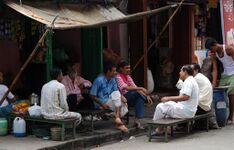LED Seminar 2016 - Landscape Symbols Reflection Group I
Landscape Symbol 1- Warsaw, Anna Janus
Representations and analytical drawings
in addition to your initial visual please add two further analytical drawings of your symbol
- GroupI slide2.JPG
slide 2
- GroupI slide3.JPG
slide 3
Reflections
Please write a 250 words text reflecting on the following questions, you can also take ideas from your group members into account
- How and why did the symbols you identify appear in your landscape?
- Did their meaning change along with socio-political, economic, environmental or cultural changes in your region, or country?
- What do these symbols mean to you today? Are they meaningful to more than just one cultural group? Are they shared across cultures?
add your text here The Palace of Culture and Science, originally known as the Joseph Stalin Palace of Culture and Science, was built in 1955. It was a 'gift from the Soviet Union to the people of Poland', as a symbol of soviet power and city reconstruction. Over the time and generations sense of the building changed. For older people The Palace reminds about Polish history and problematic past. For young people it is just centrally located building, without any emotional charge. Many consider it as ugly piece of architecture that should be destroyed or covered by other constructions. For me it is a symbol of the past. It is a well organised, useful public building that combines different cultural facilities as theatre, museum, or cinema. It also carries many art pieces of Polish artists such as paintings, sculptures, as well as furniture and architectonical details. For many it is regarded as Warsaw landmark.
Landscape Symbol 2- Saeid Saadat
Representations and analytical drawings
in addition to your initial visual please add two further analytical drawings of your symbol
Reflections
Please write a 250 words text reflecting on the following questions, you can also take ideas from your group members into account
- How and why did the symbols you identify appear in your landscape?
- Did their meaning change along with socio-political, economic, environmental or cultural changes in your region, or country?
- What do these symbols mean to you today? Are they meaningful to more than just one cultural group? Are they shared across cultures?
add your text here
Landscape Symbol 3- Tea Stall, Stuti Sareen
Representations and analytical drawings
in addition to your initial visual please add two further analytical drawings of your symbol
- GroupI slide2.JPG
slide 2
- GroupI slide3.JPG
slide 3
Reflections
Please write a 250 words text reflecting on the following questions, you can also take ideas from your group members into account
- How and why did the symbols you identify appear in your landscape?
- Did their meaning change along with socio-political, economic, environmental or cultural changes in your region, or country?
- What do these symbols mean to you today? Are they meaningful to more than just one cultural group? Are they shared across cultures?
add your text here
Landscape Symbol 4- Sebastian Sanchez Napal
Representations and analytical drawings
in addition to your initial visual please add two further analytical drawings of your symbol
- GroupI slide1.JPG
slide 1
- GroupI slide2.JPG
slide 2
- GroupI slide3.JPG
slide 3
Reflections
Please write a 250 words text reflecting on the following questions, you can also take ideas from your group members into account
- How and why did the symbols you identify appear in your landscape?
- Did their meaning change along with socio-political, economic, environmental or cultural changes in your region, or country?
- What do these symbols mean to you today? Are they meaningful to more than just one cultural group? Are they shared across cultures?
add your text here
Landscape Symbol 5- Florianopolis, Lucas Passold
Representations and analytical drawings
in addition to your initial visual please add two further analytical drawings of your symbol
- GroupI slide2.JPG
slide 2
- GroupI slide3.JPG
slide 3
Reflections
Please write a 250 words text reflecting on the following questions, you can also take ideas from your group members into account
- How and why did the symbols you identify appear in your landscape?
- Did their meaning change along with socio-political, economic, environmental or cultural changes in your region, or country?
- What do these symbols mean to you today? Are they meaningful to more than just one cultural group? Are they shared across cultures?
Florianópolis is a city well known across the country by its natural landscape, mostly because of the beautiful beaches. So the sea is totally associated with the image of the city, becoming a symbol. Since the city is an island, it is impossible to not notice it, but that doesn't necessarily mean that everybody who lives here sees the symbol in the same context. The vision of the seashore has changed along the times, coming from a place of trash disposal to become a place of leisure and human interaction. This new approach to the sea made the city invest mostly in these parts, adding value to the nearby land and expelling the bigger e poorest part of the population to the outskirts of Florianópolis. Sadly, the investments aren't good either, since they are made mostly with an infrastructure sense of providing good assets for cars (12 car lanes and 1 small pedestrian lane along the shore). The small remaining part along the shore gives only a small possibility for the people who live nearby to practice sports like running and biking. Somehow this landscape is becoming only a good symbol for the rich who has access to it, meanwhile this landscape is not a palpable symbol for the rest of the citizens who can only watch it from inside the bus on the way to work.
Group reflection
Please add a summary of your group reflection here





